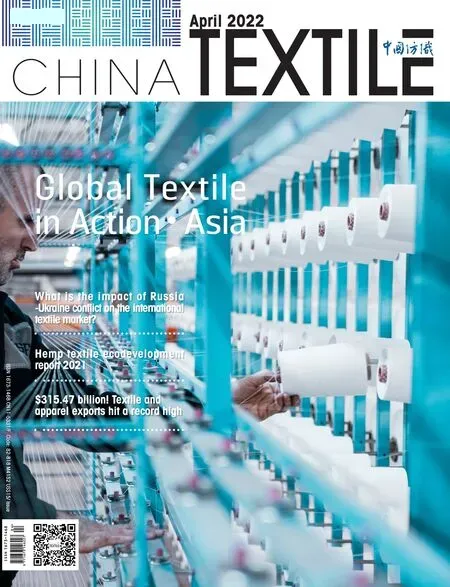HEMP TEXTILE ECODEVELOPMENT REPORT 2021
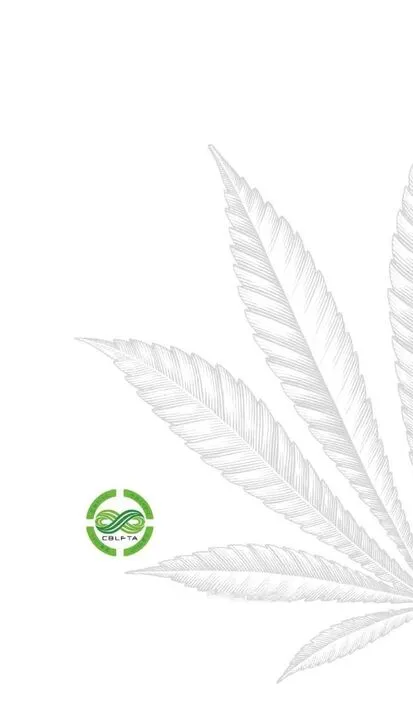
Preamble
In 2020,China’s total textile fiber processing reached 58 million tons,accounting for more than 50% of the world’s total fiber processing;China’s textile and garment exports reached US $29.9 billion,accounting for more than one-third of the world’s share and steadily ranking first in the world.Most of the indicators of China’s textile industry have reached or even led the world’s advanced level.The production and manufacturing capacity and the scale of international trade have long ranked first in the world.In the new situation,China’s textile industry has put forward new development direction of “innovation-driven technology industry,culture-led fashion industry,responsibility-oriented green industry”,is highly compatible with hemp textile industry development “green,low-carbon,sustainable”.Hemp textiles will be a typical representative of the green development of the textile industry.
Under the guidance of the national goal of achieving peak carbon emissions by 2030 and carbon neutrality by 2060,hemp textile industry will widely promote the development concept of “green,lowcarbon and sustainable”,increase the comprehensive use and development of hemp products,consolidate and improve the core competitiveness of the industry,to promote the sustainable development of the hemp textile industry.
Overview
Hemp cultivation
Hemp,also known as fire hemp,Chinese hemp,malehemp (male plants),tho (female plants),is an annual plant of the mulberry family cannabis,the entire plant can be used in its entirety.Hemp was the first natural fiber used by mankind for fabric,and has been cultivated and used for 8,000years.Hemp has been an important crop in ancient China,“five grains,cannabis,millet,millet,wheat,beans,too”,here cannabis in the five grains,specifically referring to hemp.
Nowadays,there are more than 3,000 kinds of hemp products in various categories worldwide,which are widely used in many industries such as textile,paper,food,medicine,construction and automobile,and the range of applications is currently increasing.
In China,hemp is classified as “industrial hemp”and “drug hemp” according to the EU standard,and industrial hemp refers to hemp with a tetrahydrocannabinol (THC) content of less than 0.3%.Hemp for textile fibers is industrial hemp.
Hemp is easy to plant and has relatively few inputs in the field.Extremely adaptable to the environment,tolerant of infertile conditions,resistant to adversity and widely adapted.Prefer light,photosynthetic efficiency,rapid growth does not require fertilization.The hemp crop needs 500-700 mm of precipitation to grow,but at the same time is resistant to drought,and if there is rainfall during the growing season in the areas where it is grown,there is basically no need for additional irrigation.
Hemp is an environmentally friendly cash crop.It enriches soil organic matter,reduces fertilizer inputs and has adsorption properties for pesticides,contributing to the sustainability of agricultural systems.
Comfortable and safe problems need to be solvedWithHemp fiber can be used for textiles,paper,construction materials,composite materials,etc.,hemp seeds,can extract hemp oil for cooking,hemp kernels can be made into medicinal herbs in addition to food.In recent years,the medicinal value of industrial hemp was widespread attention in many countries,has been isolated more than 500 compounds from the hemp plant,including cannabinoids,polyphenols,organic acids,alkaloids,terpenoids and flavonoids.Among them,cannabis phenolic compounds are widely studied and applied.Cannabis phenolic has two main components,tetrahydrocannabinol (THC) and cannabidiol (CBD),from industrial hemp in the bio-extraction of non-addictive non-toxic components of cannabidiol,with anti-spasmodic,anti-anxiety,anti-inflammatory pharmacological effects,is a good cure.
The use of hemp fiber is most common and developed in China.Hemp fiber is a cellulosic bast fire found in the stalk of the hemp plant and is obtained through decortication processes.
The application of hemp as a textile raw material originated in China,known as the “king of natural fibers”,is a functional natural fiber.With moisture absorption and breathability,anti-mildew and anti-bacteria,odor absorption,anti-radiation,anti-UV,anti-static and many other unique functions.Hemp fiber,like organic cotton,is a globally recognized eco-friendly fiber resource,not ordinary cotton,flax can be compared.
The cultivation and processing of industrial hemp in China has to be approved by the public security authorities,and currently Yunnan and Heilongjiang legally open to industrial hemp cultivation.On 6 March 2019,the Office of the National Anti-Drug Commission issued the “Notice on Strengthening the Control of Industrial Hemp”,proposing that hemp is a controlled drug according to the provisions of “Single Convention on Narcotic Drugs of 1961,However,in August 1975 the Convention clearly stated:“This Convention shall not cover the cultivation of hemp plants exclusively for industrial use (fiber and seeds) or for horticultural use”.So industrial hemp use is currently limited to fiber and seeds.As a party to “‘the Single Convention on Narcotic Drugs of 1961”,we are bound by its provisions.
The early cultivation of hemp in China was mainly for fiber and seed use,with some recent cultivation of medicinal hemp in Yunnan.The fiber textile application of hemp is the main use of hemp in China.The hemp textile industry has developed rapidly in recent years,and since 2016 the area under fiber hemp cultivation in China has remained at 20,000 to 30,000 ha yearround,with a fiber output of around 30,000 to 40,000 tones.
Hemp cultivation for fibers is mainly concentrated in Heilongjiang province,with other provinces and regions such as Shanxi and Jilin also having cultivation.Heilongjiang’s vast black land and climatic conditions are ideal for industrial cultivation and is the main source of high-quality rain fed hemp in China,the cultivation area has been maintained at over 250,000 mu since 2016.
At present,only China,Canada,Germany and a few other countries have applied hemp fiber textile technology.China is in the leading position internationally,with a hemp processing and application industry chain consisting of hemp cultivation,fiber processing,chemical auxiliaries,spinning and weaving,clothing and home textiles,viscose fibers,paper making,automotive interiors,new building materials,composite materials,food and health care,activated carbon and other industries.China’s industrial hemp has seen rapid development during the 13th Five-Year Plan period.Since 2018,the cultivation and application of industrial hemp and medical hemp have been legal internationally,and the attentions to hemp products has never been higher,both internationally and domestically.The area under industrial hemp cultivation in China has also increased rapidly,and has now become the largest hemp species in the country.At present,only China,Canada,Germany and a few other countries have applied hemp fiber textile technology.China is in the leading position internationally,with a hemp processing and application industry chain consisting of hemp cultivation,fiber processing,chemical auxiliaries,spinning and weaving,clothing and home textiles,viscose fibers,paper making,automotive interiors,new building materials,composite materials,food and health care,activated carbon and other industries.China’s industrial hemp has seen rapid development during the 13th Five-Year Plan period.Since 2018,the cultivation and application of industrial hemp and medical hemp have been legal internationally,and the attentions to hemp products has never been higher,both internationally and domestically.The area under industrial hemp cultivation in China has also increased rapidly,and has now become the largest hemp species in the country.
Hemp textile processing route
The hemp textile industry is the most internationally competitive of China’s traditional advantages in the textile industry.Chinese hemp textile technology has an absolute leading edge,and its processing follows the traditional flax spinning route and the traditional cotton spinning rout.
After strict degumming treatment of hemp fibers have large cavity,there are many longitudinal fissures and pores,and connected with the cavity.Therefore,hemp fibers have excellent moisture absorption and breathable properties.In the dry climate of spring and autumn,as well as winter,hemp fibers have good warmth,while in the summer and cool and pleasant.One hand,hemp fibers in the molecular hydrophilic genes and water molecules easily combined with water molecules and adsorption of water molecules,its loose molecular structure and hollow shape,and can fill a large number of capillary condensation water,so that hemp fibers absorb more moisture quickly;on the other hand,on the surface of hemp fiber,the dense fissures and pores and moisture dispersion is beneficial.Therefore,hemp fabrics are very suitable for clothing,home textile products.

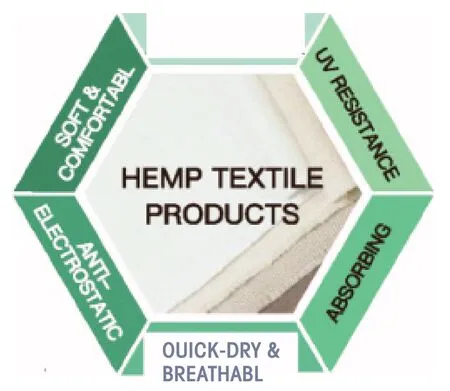
Hemp fibers have a porous structure and strong adsorption properties,in the natural state,hemp fibers will adsorb more oxygen,so that the survival of anaerobic bacteria environment is damaged,which makes hemp in the natural state,hemp fibers will absorb more oxygen,so that the survival of anaerobic bacteria environment is damaged,which makes hemp in the structure has the advantage of antibacterial.At the same time,hemp fabrics can make the body’s sweat faster,thus destroying the moisture environment for the survival of bacteria,showing a high antibacterial performance.In addition,the hemp plant contains a variety of active phenolic substances,organic acids and inorganic salts,which have a significant killing and inhibiting effect on a variety of bacteria.Chinese Academy of Military Medical Sciences Institute of Microbiology Epidemiology according to the United States AATCCgO-1982 qualitative inhibition method test (inhibition diameter greater than 6 mm,that is,the inhibition effect),hemp fabric on different microbial inhibition circle diameter size were:Staphylococcus aureus 9.1mm,Pseudomonas aeruginosa7.6mm,Escherichia coli 10mm,Candida albicans 6.3mm.at the same time,it has a significant killing and inhibiting effect on Trichoderma gypsum,Penicillium and Aspergillus.
Hemp fiber molecular structure is stable,good orientation on molecular arrangement,dried hemp fibers are still a poor conductor of electricity,its insulation is better than cotton fibers.Under the same test conditions,the static voltage of pure hemp fabric is about twice higher than the hemp-cotton fabric,and also higher than the polyester-hemp fabric.Due to the good moisture absorption properties of hemp fibers,the moisture content is generally maintained at around 12%,In the case of air humidity up to 95%,its moisture content of up to 30%,but the feel does not feel damp,so hemp textiles can easily avoid the accumulation of static electricity.it will not be caused by mechanical processing or clothing swing friction caused by dust adsorption,pilling or discharge.It has been determined that the specific resistance of hemp fibers is higher than that of cotton fibers.In all flax fibers,the resistance of hemp fiber only lower than ramie fiber,it can be seen that the hemp fiber is good on anti-static performance.
Hemp fabric has excellent resistance on ultraviolet radiation performance,the main reason is that the crosssection of hemp fiber is irregular triangular,quadrilateral,hexagonal,flat,rounded or polygonal,etc.,the cavity is linear or oval;from the analysis of the molecular structure of hemp fibers,its molecular structure in the spiral line pattern,multi-pronged,more loose.After the light or sound waves into,so that the light waves,sound waves in the crystalline area of hemp fibers to be formed diffuse reflection and multi-layer light refraction,in the amorphous area of the fiber molecules,gaps and holes such as mud,widely damaged and absorbed,so that the hemp fabric has a good function of UV radiation.The Chinese Academy of Sciences Institute of Physics test,general hemp fabrics without special finishing,can shield most of the ultraviolet radiation.
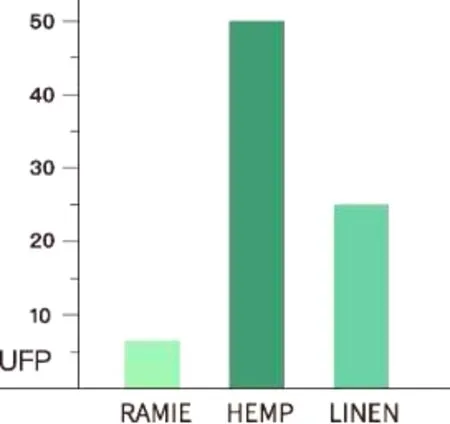
Ultraviolet Protection Index UPF values for several flax fabrics
Hemp fibers of single fiber length of 15 to 25 mm,fineness of 15 to 30 microns,specific gravity of 1.48,lighter than flax,single fiber breaking strength is also better than flax and cotton.Molecular structure is longitudinally arranged,tight and neat,crystallinity and orientation are very high.Hemp fibers are the thinnest of all kinds of hemp fibers,close to cotton fibers,and the end is obtusely shaped,so the hemp fibers cotton-type treatment,the fabric feels extremely soft,without special treatment to avoid other hemp products prickly and rough feeling.
Hemp fibers have excellent chemical adsorption properties.Through the cotton fiber and formaldehyde,benzene,TVOC adsorption experiments compared,under the same conditions,the adsorption capacity of hemp fibers is much stronger than cotton fibers.This is related to its single-fiber structure form,the porous structure of hemp fibers to increase its specific surface area,adsorption performance greatly improved.
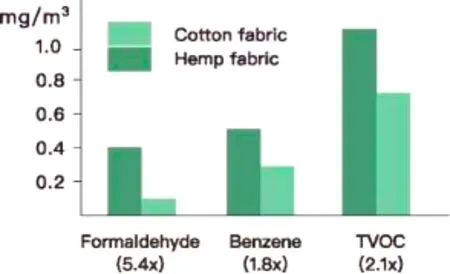
Comparison of the adsorption of formaldehyde,benzene and TVOC of hemp and cotton
According to “National Catalogue for the Guidance of Industrial Structure Adjustment” in 2019,“processing of special natural fiber products that meet the requirements of ecology,comprehensive utilization of resources and environmental protection” has been explicitly included in the “encouraged category of entries in the textile industry11.
At present,the hemp textile industry already has a complete manufacturing chain and independent intellectual property rights core technology from hemp degumming,carding,spinning,weaving,garment,home textile and industrial use,and its research and development technology and manufacturing level are in the leading position internationally.
Until the end of 2020,the hemp textile production capacity in China is roughly as follows,hemp fiber degumming capacity of 20,000 tons/year;hemp long fiber spinning capacity of 40,000 spindles;hemp blending (regular) capacity of about 150,000 spindles.At present,China has the most advanced hemp long fiber spinning production lines in the world,the most advanced hemp blending production lines,and also has a hemp textile green demonstration factory with solar energy covering the whole factory.
Due to the eco and sustainable characteristics with hemp fiber,hemp is also blended with better cotton,modal,recycled polyester and a range of other environmentally friendly fibers to reflect the eco and environmentally friendly characteristics of hemp blended fabrics.
Through the continuous efforts of many hemp textile enterprises,hemp textile products are becoming more and more abundant,and hemp textile products will be more and more recognized in the international market.The cumulative exports of hemp yarn and fabric in 2020 increased by 30.97% compared to 2016.The number and amount of hemp textile products exported is still small quantity compare to flax products,but on constant growing.
In recent years,with the improvement of people’s quality of life,eco environmental protection,return to the basics of the fashion trend is increasing.As an eco-fiber,hemp fabrics have natural functional characteristics,but also has a dignified and elegant,simple,natural and practical style.Therefore,hemp textiles have a deep eco concept and a broad base of hemp culture consumption.
Sustainable development of hemp industry
Carbon footprint characteristics of hemp cultivation
Hemp is a multi-purpose,high value-added,renewable economic crop,hemp bast fibers can replace cotton,shives can replace wood,widely used in textiles,construction,automotive and other industries;hemp seeds can replace oil to produce biodiesel,the performance is comparable to fossil diesel;hemp concrete is strong and durable,fire and moisture resistant,and has the function of CO2 adsorption.
Hemp cultivation process does not use pesticides,fertilizers,pesticides,basically no additional irrigation,hemp plants have excellent ecological,resource and environmental protection.
The hemp plant is highly tolerant to the heavy metal cadmium,and when the cadmium content in the soil reaches 800mg/Kg,there is no significant impact on the hemp’s growth.Hemp has a high biological yield,especially suitable for intercropping rotations,a season of hemp stalk output equivalent to a year of fast-growing forests.Hemp bast fiber output can reach more than 100kg/mu.The monolayer adsorption capacity of hemp to chromium ions,copper ions,silver ions,cadmium ions are 367mg/g,1,157mg/g,89mg/g,140mg/g.Both hemp plants and hemp fibers are excellent natural metal adsorbents,providing an effective self-cleaning effect to water bodies and soil.
According to the test data provided by the High Value Special Biological Resources Industrial Technology Innovation Alliance conducted in Yunnan,the biomass per unit area of hemp is about 17,368.36kg per hectare,with a carbon sequestration of about 7.815 tons per hectare,which translates into a CO2 uptake of about 28.657 tons.
The biomass value per unit area of cotton was about 7,661.55kg/hm2,with a carbon sequestration of about 3.83 tons per hectare,which translates into a carbon dioxide uptake of about 14.01 tons.It can be seen that during the growing process,hemp can effectively absorb about twice as much carbon dioxide per hectare as cotton.

Comparison of discounted CO2 uptake average cultivation data between hemp and jute and cotton
In addition to the carbon sinks produced from the biological mass,hemp cultivating is basically free of chemical fertilizers and pesticides,while the growth of cash crops such as cotton requires the application of chemical fertilizers,as well as the spraying of pesticides and herbicides,but these chemical materials are all high energy-consuming products,which translate into huge carbon dioxide emissions,and it is estimated that they may offset around 50% of the carbon sinks produced by cultivation.
Although there are relatively large differences in biomass production and use of cannabis cultivation between different regions,it is no doubt that hemp cultivation,as a high biomass producer,has very good carbon sinks.
Carbon emissions from hemp fiber processing and additional product environmental characteristics
Based on the “PAS 2050:2008 Specification for the Evaluation of Greenhouse Gas Emissions of Goods and Services over the Life Cycle” as a standard for product carbon footprint methodology.There are five basic steps in the carbon footprint of any goods or services:1.Drawing process map (flow chart);2.Checking and prioritizing boundaries;3.Collecting data;4.Calculating carbon footprints;5.Checking uncertainties.
The results of hemp fiber carbon emissions from Yunnan hemp data provided by the High Value Special Biological Resources Industry Technology Innovation Strategy Alliance are as follows.Carbon emissions from the growing process:mainly includes two parts:carbon absorption during hemp growing process and carbon emissions from the planting and harvesting of hemp.During the growing period,the amount of carbon dioxide absorbed per ton of hemp bast is approximately 1.651 tons;during planting and harvesting,each ton of raw hemp harvested produces carbon dioxide emissions of approximately 0.011 ton.
Carbon emissions from the transport process:mainly generated at transportation stage of chemicals and hemp bast.The formula is:carbon emissions=activity level data x emission factor.0.058 ton of carbon dioxide emissions per ton of hemp fiber.
Carbon emissions from the process:Carbon emissions are mainly generated from energy consumption and chemical use.Energy consumption is mainly electricity and coal consumption;chemicals are mainly caustic soda and hydrogen peroxide,which are used in three stages:clear water treatment,degumming process and sewage treatment.Calculation formula:Carbon emissions=activity level data x emission factor.Each ton of hemp fiber emits 7.332 tons of carbon dioxide.
Combining the whole process of cultivation,transport and production and processing,the converted carbon emissions per 1000 kg of hemp fiber within its life cycle are approximately 7.332+0.058+0.011*5-1.651*2=4.143 tons of CO2.
Based on the “PAS 2050:2008 Specification for the Evaluation of Greenhouse Gas Emissions of Goods and Services over the Life Cycle”as a standard for product carbon footprint methodology.There are five basic steps in the carbon footprint of any goods or services:1.Drawing a process map (flow chart);2.Checking and prioritizing boundaries;3.Collecting data;4.Calculating carbon footprints;5.Checking uncertainties.
Hemp concrete is a type of concrete made from hemp and lime.It is stronger than traditional concrete,but weighs only one-seventh of conventional concrete.It is a durable building material that is fire,insect,poison and smoke resistant,as well as resisting cracks and providing effi-cient insulation that can reduce energy costs by up to 70% per year.Conventional construction uses a large number of synthetic and potentially toxic materials that have the potential to release toxic chemicals when wet and moldy.Hemp concrete does not release toxins into the indoor air and also has an anti-fungal effect.
Industrial hemp pulp quality is between the coniferous wood pulp and broadleaf wood pulp,is a high-quality raw material for paper,can be used as an alternative to wood pulp paper one of the preferred raw materials for paper,about 400 million tons of paper are produced worldwide each year,and it takes an average of 17 trees to produce one ton of paper.This means that 6.8 billion trees are cut down each year to make paper.Unlike trees,industrial hemp grows quickly and is easy to grow;trees have only 30% cellulose and require chemicals to get rid of other impurities,while hemp has 85% cellulose;hemp paper is more durable than tree paper,difficult change to yellow,crack,or deteriorate,and can be used as a specialty paper.
Hemp composite board to hemp shives as the main material,add a certain proportion of resin and additives,through certain technical means made of composite board,is the original nature of synthetic environmentally friendly materials,with “energysaving,safe,recyclable” characteristics,in line with the direction of new material development.
In research abroad,a side board made of ABS copolymer and an alternative design made of hemp fiber (volume content:66%) epoxy resin composite were evaluated for the Audi A3.The application of hemp fibers resulted in a 45%reduction in energy consumption and CO2 emissions in the production of the side panels of the Audi A3.
Hemp stalks core cellulose content of about 50%,and close to coniferous wood,broadleaf wood,with a lower lignin content than wood,the use of hemp stalk cores to produce viscose fibers not only realizes the comprehensive use of biomass resources,but also alleviates the serious shortage of viscose raw materials in China.In addition,the viscose fiber produced has natural antibacterial and anti-UV properties,and is a new functional viscose fiber with higher added value than ordinary cotton staple viscose fiber.
The plastic bags and water bottle we use in our lives may take 400 to 1000 years to decompose.While the basic building blocks of plastic come from petroleum derivatives,industrial hemp is a fast-growing,high-matterproducing energy plant with three to four times the biological output of trees,a more advantageous fiber output and,most importantly,industrial hemp plastic is as durable and lightweight as traditional plastic,and industrial hemp plastic is usually 100% biodegradable.
The world has been using oil for industrial purposes for over a hundred years and for a century there has been concern that with the growing consumption of oil,scientists have also been looking for fuels that could replace it.Hemp seeds are rich in oils and can be converted into fatty acid methyl esters with a conversion rate of over 75%,which can produce biodiesel.Hemp seed oil can also be used to produce non-toxic paints,coatings,lubricants and household lighting oil;hemp stalk cores can be compressed into particles and burned directly to create electricity.As a biofuel,industrial hemp is more sustainable than fossil fuels.According to the results of international studies,each ton of biomass burned in place of natural degradation can achieve a reduction of 19.014 tons of carbon dioxide equivalent emissions,as measured by the basic laws of the existing carbon cycle.

Test results comparation of hemp stalk core activated carbon with bamboo charcoal
Hemp stalk core has a light porous structure,so it is the best raw material for the production of activated carbon.The activated carbon produced from hemp stalk cores has a specific surface area of 2,000m2/g,up to 3,400m2/g,which is one of the best-known activated carbons,and can be widely used in chemical and industrial protective clothing.
The protein content of whole hempseeds is generally between 20-25% and it also has a very high dietary fiber content.It is worth noting that hemp seeds contain 21 amino acids,including 8 essential amino acids,and that hem p protein is easily digestible and allergen-free.Hemp protein products are highly prized by consumers as a green food.

Social responsibility
The urgency of the global climate governance situation is highlighted,hemp textiles will actively participle in promoting social responsibility and sustainable development,China has set the goal of achieving peak carbon emissions by 2030 and carbon neutrality by 2060.The whole industry will forge a consensus and base its development on the overall national ecological strategy,taking sustainable development as an important way to enhance the value and the responsibility of a strong textile country.
Green trends in hemp textiles
The environmental and ecological risks brought about by global warming are one of the most serious threats to human survival,and the reduction of carbon dioxide emissions has become a responsibility shared by all practitioners in the hemp industry.China Bast &Leaf Fibers Textile Association will gradually promote the integration of the industry’s environmental responsibility into the industry’s value system,innovation system and management system,effectively promoting the industry’s ecological and sustainable development.
The counter-globalization caused by covid-19 has prompted countries to accelerate the restructuring of their industrial systems for supply chain security reasons.The supply of hemp fiber has shown the possibility of replacing flax fiber,and the construction of a green supply chain system with hemp traceability is an important tool for industry associations to promote the hemp textile industry in a comprehensive manner.The carbon sink advantages of hemp cultivation and the eco-friendly and sustainable concept of hemp textiles,as a new force for economic growth,will provide important support for the rapid development of the hemp textile industry.
With China’s goal of achieving a moderately prosperous society,the average fiber consumption of domestic residents has reached the level of medium developed countries,led by the major trend of domestic consumption upgrading,green,healthy,safe and comfortable is becoming more and more basic life demand of consumers for textiles and clothing,especially on COVID-19 time,people pay more attention to safety and health,and the green consumer trend will provide the textile industry with the right market orientation under the general domestic cycle.
Hemp textile carbon balance development directions
China has not yet formulated national laws and regulations on industrial hemp,and industrial hemp has not been fully legalized nationwide.The current regulations on industrial hemp are scattered in documents issued by the Ministry of Agriculture,the National Development and Reform Commission,the Ministry of Commerce,and various provinces and localities,and several policies and regulations that have strict restrictions on the development of industrial hemp.However,fiber-use hemp has been legally cultivated in several provinces,and the China Hemp Textile Association will continue to promote fiber-use hemp cultivation and integrated processing in Heilongjiang and Shanxi,with reasonable control on the scale of cultivation,step-by-step and steady development,and promotion of hemp integrated utilization technology.
The hemp industry requires scientific and technological innovation to promote the development of varieties and their seed breeding,cultivation techniques,special machinery development,new raw material processing techniques,production processes and product development,comprehensive utilization,as well as its supporting information,services,sales and distribution to strengthen cooperation in all aspects,building innovation platforms and carriers,cultivating superior varieties,focusing on industrial hemp green production and the development of new industrial applications.
Guide and support the construction of low-energy and lowwater consumption projects in enterprises.Encourage enterprises to continue to increase the proportion of secondary energy consumption,use renewable energy such as solar energy as supple-mentary energy,promote good accounting of carbon dioxide emissions by enterprises,and set up models of “double reduction” demonstration enterprises in air pollutant emissions and carbon emission reduction.Encourage the adoption of intelligent technology on spinning,weaving,dyeing and finishing,garment processing and other equipment to improve labor productivity.Accelerate the development of energy-saving and low-carbon standards for hemp industry and encourage green design of factory buildings.
Take green technology-driven industrial chain links to reduce pollutant production and emission as the core,and improve systematic pollution prevention and control in the whole production process.Increase efforts to transform clean production and continuously reduce the production and emission of key pollutants such as chemical oxygen demand,ammonia nitrogen and nitrogen oxides.Encourage hemp fiber processing enterprises and textile enterprises to promote the development of less water and chemical processing processes,increase the development of recycled water,reclaimed water and other unconventional water resources,strengthen water management and water system integration and optimization,and create a number of typical green processing demonstration projects and benchmark enterprises.
Regarding to the low-carbon development of the hemp industry,the solution must come from continuous scientific and technological innovation.Hemp textiles and comprehensive utilization are important elements of innovation.In the future,by increasing technologicaI innovation in integrated use and improving the added value of products,hemp will certainly shine in the “green area” of new materials,new energy technologies and new processes.
- China Textile的其它文章
- Global Textile in Action ? Asia
- India:Measures to boost exports,production,and job opportunities
- Pakistan:The 2022 investment will up to USD 3.5 billion
- Bangladesh:Reasons to promote the growth of textile industry
- Dear readers:
- Japan:Occupy an important position in the high-end textiles field

